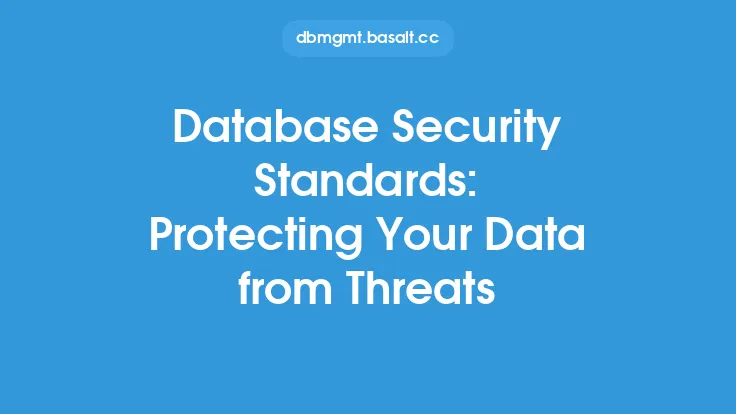As the importance of data protection continues to grow, ensuring the security of database backups has become a critical aspect of any organization's data management strategy. Database backups are a vital component of disaster recovery and business continuity planning, but they can also be a vulnerable target for unauthorized access. If backups fall into the wrong hands, sensitive data can be compromised, leading to serious consequences, including data breaches, financial loss, and reputational damage. Therefore, it is essential to implement robust security measures to protect database backups from unauthorized access.
Introduction to Database Backup Security
Database backup security refers to the practices and technologies used to protect database backups from unauthorized access, use, disclosure, disruption, modification, or destruction. This includes ensuring that backups are stored securely, transmitted safely, and accessed only by authorized personnel. Effective database backup security requires a combination of technical, administrative, and physical controls to prevent data breaches and ensure the confidentiality, integrity, and availability of backup data.
Threats to Database Backup Security
There are several threats to database backup security, including unauthorized access, data breaches, malware and ransomware attacks, insider threats, and physical theft or loss of backup media. Unauthorized access occurs when individuals or systems gain access to backup data without proper authorization, while data breaches involve the unauthorized disclosure of sensitive data. Malware and ransomware attacks can compromise backup data, making it inaccessible or unusable, while insider threats come from authorized personnel who intentionally or unintentionally compromise backup security. Physical theft or loss of backup media can also lead to unauthorized access to sensitive data.
Best Practices for Database Backup Security
To protect database backups from unauthorized access, several best practices can be implemented. These include encrypting backup data, both in transit and at rest, using secure protocols for data transmission, and storing backups in a secure location, such as an offsite data center or cloud storage service. Access controls, including authentication, authorization, and accounting (AAA), should be implemented to ensure that only authorized personnel can access backup data. Backup data should also be regularly monitored for signs of unauthorized access or other security threats, and incident response plans should be in place in case of a security breach.
Encryption and Access Control
Encryption is a critical component of database backup security, as it ensures that even if backup data is accessed unauthorized, it will be unreadable without the decryption key. There are several encryption algorithms and protocols available, including Advanced Encryption Standard (AES), Secure Sockets Layer/Transport Layer Security (SSL/TLS), and Internet Protocol Security (IPSec). Access controls, including AAA, should also be implemented to ensure that only authorized personnel can access backup data. This includes using strong passwords, multi-factor authentication, and role-based access control to limit access to backup data.
Secure Storage and Transmission
Secure storage and transmission of database backups are also essential for protecting against unauthorized access. This includes storing backups in a secure location, such as an offsite data center or cloud storage service, and using secure protocols for data transmission, such as SSL/TLS or IPSec. Backup data should also be regularly verified to ensure that it is complete, accurate, and usable in case of a disaster recovery scenario.
Monitoring and Incident Response
Regular monitoring of database backups is critical for detecting signs of unauthorized access or other security threats. This includes monitoring backup data for signs of tampering, unauthorized access, or other security threats, and implementing incident response plans in case of a security breach. Incident response plans should include procedures for containing and eradicating security threats, recovering from security breaches, and post-incident activities, such as conducting a root cause analysis and implementing measures to prevent similar incidents in the future.
Physical Security
Physical security is also an essential aspect of database backup security, as it ensures that backup media, such as tapes or disks, are protected from physical theft or loss. This includes storing backup media in a secure location, such as a locked cabinet or safe, and using tamper-evident tape or other security measures to prevent unauthorized access. Backup media should also be regularly inventoried and tracked to ensure that it is accounted for and stored securely.
Cloud-Based Database Backup Security
Cloud-based database backup security requires special consideration, as cloud storage services can introduce additional security risks. This includes ensuring that cloud storage services use robust security measures, such as encryption and access controls, to protect backup data. Cloud-based backups should also be regularly monitored for signs of unauthorized access or other security threats, and incident response plans should be in place in case of a security breach.
Conclusion
In conclusion, database backup security is a critical aspect of any organization's data management strategy. By implementing robust security measures, such as encryption, access controls, secure storage and transmission, monitoring, and incident response, organizations can protect their database backups from unauthorized access and ensure the confidentiality, integrity, and availability of backup data. Regular monitoring and incident response planning are also essential for detecting and responding to security threats, and cloud-based database backup security requires special consideration to ensure that backup data is protected in the cloud. By following these best practices, organizations can ensure that their database backups are secure and usable in case of a disaster recovery scenario.





